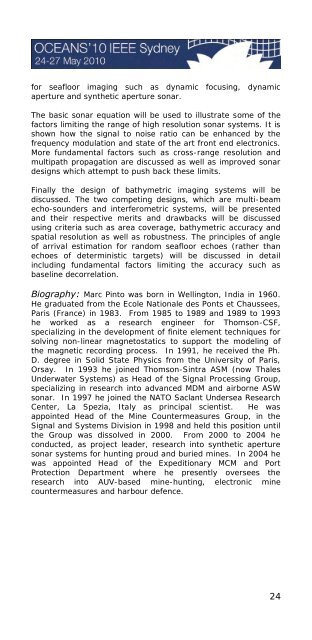Program Book - Oceans'10 IEEE Sydney
Program Book - Oceans'10 IEEE Sydney
Program Book - Oceans'10 IEEE Sydney
You also want an ePaper? Increase the reach of your titles
YUMPU automatically turns print PDFs into web optimized ePapers that Google loves.
for seafloor imaging such as dynamic focusing, dynamic<br />
aperture and synthetic aperture sonar.<br />
The basic sonar equation will be used to illustrate some of the<br />
factors limiting the range of high resolution sonar systems. It is<br />
shown how the signal to noise ratio can be enhanced by the<br />
frequency modulation and state of the art front end electronics.<br />
More fundamental factors such as cross-range resolution and<br />
multipath propagation are discussed as well as improved sonar<br />
designs which attempt to push back these limits.<br />
Finally the design of bathymetric imaging systems will be<br />
discussed. The two competing designs, which are multi-beam<br />
echo-sounders and interferometric systems, will be presented<br />
and their respective merits and drawbacks will be discussed<br />
using criteria such as area coverage, bathymetric accuracy and<br />
spatial resolution as well as robustness. The principles of angle<br />
of arrival estimation for random seafloor echoes (rather than<br />
echoes of deterministic targets) will be discussed in detail<br />
including fundamental factors limiting the accuracy such as<br />
baseline decorrelation.<br />
Biography: Marc Pinto was born in Wellington, India in 1960.<br />
He graduated from the Ecole Nationale des Ponts et Chaussees,<br />
Paris (France) in 1983. From 1985 to 1989 and 1989 to 1993<br />
he worked as a research engineer for Thomson-CSF,<br />
specializing in the development of finite element techniques for<br />
solving non-linear magnetostatics to support the modeling of<br />
the magnetic recording process. In 1991, he received the Ph.<br />
D. degree in Solid State Physics from the University of Paris,<br />
Orsay. In 1993 he joined Thomson-Sintra ASM (now Thales<br />
Underwater Systems) as Head of the Signal Processing Group,<br />
specializing in research into advanced MDM and airborne ASW<br />
sonar. In 1997 he joined the NATO Saclant Undersea Research<br />
Center, La Spezia, Italy as principal scientist. He was<br />
appointed Head of the Mine Countermeasures Group, in the<br />
Signal and Systems Division in 1998 and held this position until<br />
the Group was dissolved in 2000. From 2000 to 2004 he<br />
conducted, as project leader, research into synthetic aperture<br />
sonar systems for hunting proud and buried mines. In 2004 he<br />
was appointed Head of the Expeditionary MCM and Port<br />
Protection Department where he presently oversees the<br />
research into AUV-based mine-hunting, electronic mine<br />
countermeasures and harbour defence.<br />
24


